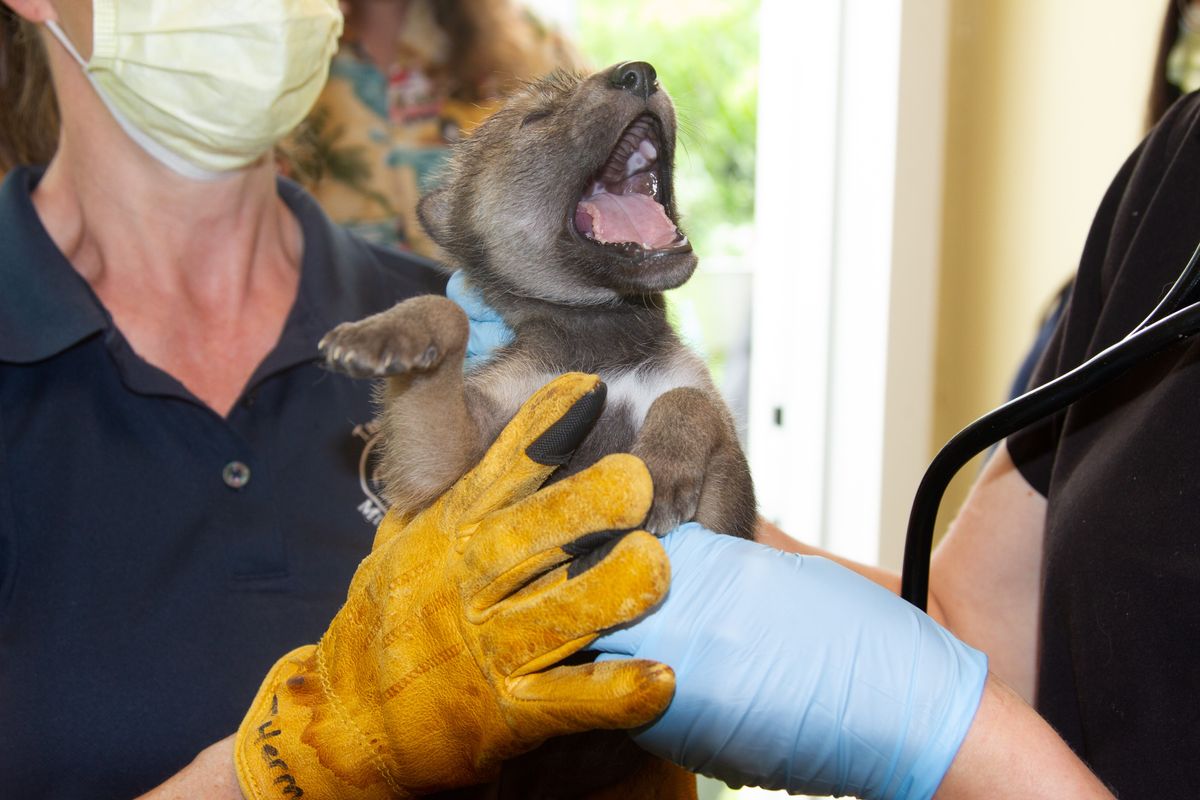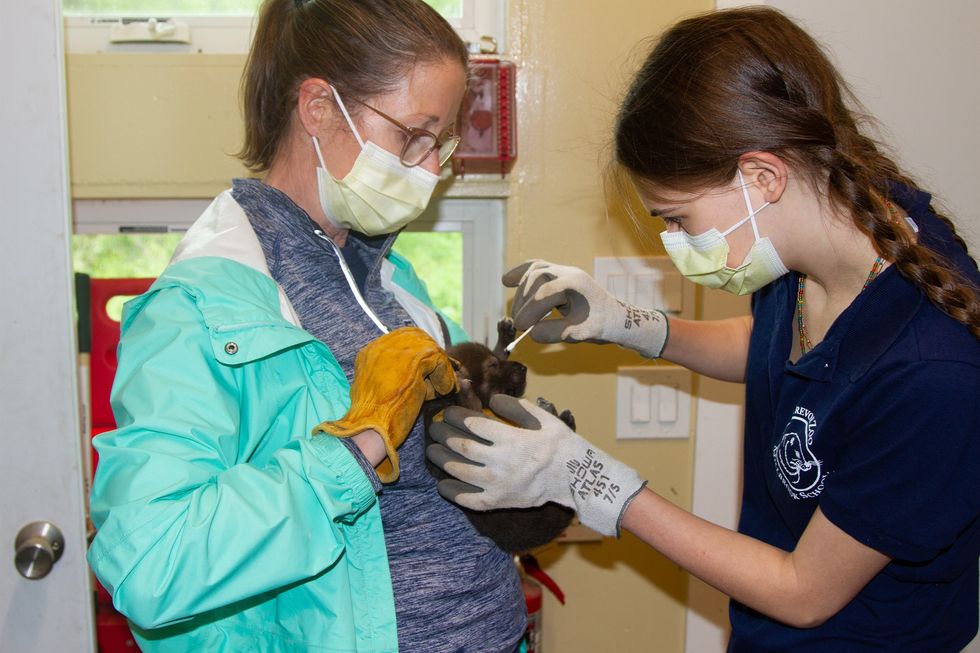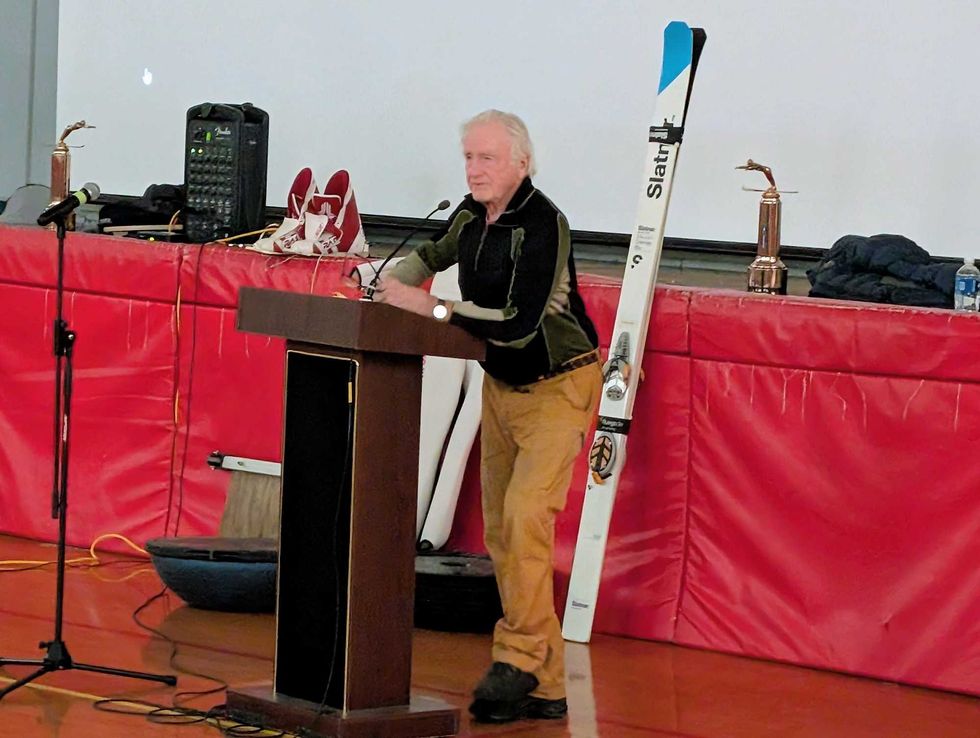Endangered red wolf pups born in Trevor Zoo

Red wolf pup, shown at about three weeks old, is one of four born at the Millbrook School’s Trevor Zoo last month.
Daniel Cohen

Red wolf pup, shown at about three weeks old, is one of four born at the Millbrook School’s Trevor Zoo last month.
MILLBROOK — Six weeks ago the Millbrook School’s Trevor Zoo celebrated the birth of four endangered Red Wolf pups, described as the rarest large carnivore in America.
Their birthday was May 2, and since that day zoo staff has left the pups in their mother’s care, avoiding human dependency because the plan is to eventually introduce them to the wild.
Through the nonprofit Association of Zoos and Aquariums (AZA) program — known as SAFE (Saving Animals From Extinction) programs — the Trevor Zoo, along with similar institutions, has collaborated to prevent the extinction of endangered species.
The birth of the four pups exemplifies the effectiveness of breeding programs and demonstrates Trevor Zoo’s commitment to wildlife conservation. According to the zoo’s website, it currently holds eleven endangered species.
Recommendations from AZA paved the way for the zoo to receive a male and female from other facilities involved in the Red Wolf SAFE program. The wolves traveled by plane and car and were then placed into an off-exhibit enclosure to allow nature to take its course.
The pups were ultimately delivered in the “den,” which is visible through one of the zoo’s live stream camera feeds. It is a compact and dark cube with an opening to its enclosure.
Including the four new pups, the zoo currently hosts eight Red Wolves, which are among less than 270 in the world, mostly at AZA accredited facilities and a “small population in the wild in North Carolina,” the web site notes.
“You don’t want them to be human oriented at all. So we really try to be hands-off other than getting them set up and of course, we have to bring them food, etc.
“But we’re trying to do that in ways that minimize contact with humans so that should pups be born, they are listening to mom more than they are to us, “ said Alan Tousignant, Director of the Trevor Zoo.

Though the plan is tentative and based on the observed behavior of the pups, introduction into the wild would start at what is called a pre-release site. The site would be an enclosed location adjacent to their wild habitat. As hunger is a strong driver for the wolves, presenting live food and allowing them to feel out their new circumstances acts as an initiation for life in the wild.
In the United States, the wild Red Wolf population resides on the coast of North Carolina. Peaking in 2006, the Red Wolf population has been declining. For this reason preserving genetic diversity is vital to the survival of the species.
“These programs are trying to maintain high genetic diversity in the populations. That’s really difficult when you’re trying to work with a population that only has 30 individuals left in the wild,” said Tousignant.
He compares the moving of endangered animals for breeding to a game of chess, where every decision affects the next, but instead of protecting the king in the case of a chess game, here the survival of a species is at risk.
The zoo has a long-standing history of conservation. Tousignant explained that the zoo was first accredited by the AZA in 1989, which allowed it to be involved in Species Rival Plans (SSP), the predecessor of SAFE.
Although Red Pandas are among the most recognizable endangered species protected at the zoo, another SAFE program focuses on the freshwater turtles inhabiting the wetlands around Millbrook School.
“As part of class, we can just get out of class and walk a quarter mile down the street and we’re in a wetland habitat.
“Campus houses a good if not thriving population of wood turtles and that’s an endangered species recognized globally…in New York state [they are] listed as a species of special concern,” says Tousignant.

The late Thomas Lovejoy, a renowned conservationist, got his start by studying biodiversity and biology at the Millbrook School. Lovejoy served on the environmental council for the Reagan, Bush, and Clinton administrations.
Lovejoy’s efforts provide Millbrook and the Trevor Zoo a special connection to the world of conservation. After his death in 2021, Lovejoy’s legacy lives on.
Semi-jokingly, Tousignant says his main job is to, “... find and motivate the next Tom Lovejoy.”
Tousignant’s hope aligns with efforts the zoo takes to get students as involved as possible in their time at Millbrook School.
“That’s what I think we have the possibility to do is to continue to find students that develop that level of passion and it becomes their life’s work. I certainly think that I’ve had advisees and students here at the zoo that are already in that role and are on path so we hope to keep doing that,” he said.
With careful supervision, students are given responsibilities tending to the animals — a rarity for zoo programs. The zoo staff believes this is the way to foster a real connection and engagement with nature.
Through summer volunteer programs, the zoo seeks students interested in conservation activities and its academic program.
The Trevor Zoo draws family visitors, especially those with children. Go to: www.millbrook.org/trevor-zoo-home for more information and live cameras inside the wolf den.
Gavin Marr is an intern at The Millerton News. He graduated from the Millbrook School in 2022. Before his first year at Millbrook he volunteered at the zoo, and in his freshman year he worked with the Black and White Ruffed Lemurs.
Berlin High School’s football team rejoices after a last-minute win in the Class M championship game Saturday, Dec. 13.
In December’s deep freeze, football players showed their grit in state playoff tournaments.
Connecticut Interscholastic Athletic Conference named six state champions in football. The divisions are based on school size: Class LL included schools with enrollment greater than 786; Class L was 613 to 785; Class MM was 508 to 612; Class M was 405 to 507; Class SS was 337 to 404; and Class S was fewer than 336.
Eight teams qualified for each tournament and all championship games were played on Saturday, Dec. 13.
Class LL was won by Greenwich High School for the second straight year. Greenwich beat Southington High School 45-6 to win the tournament. Jack Kelly rushed in three touchdowns for the Cardinals and caught a fourth.
Class L was won by New Canaan High School, which completed an undefeated season. New Canaan beat Cheshire High School 34-13 for the school’s fourth-straight state title. In the regular season, New Canaan defeated Greenwich 14-7.
Class MM was won by Windsor High School, which defeated Bunnell High School 23-13. Windsor quarterback A.J. Robinson threw for 140 yards with a passing touchdown and two rushing touchdowns.
Class M was won in the final minute by Berlin High School 20-15 over Brookfield High School. The thriller came down to the wire. Brookfield went ahead with a late touchdown. Then on the kickoff that followed, Berlin’s Eli Rice ran it 80-yards to the house to take the lead with 33 seconds remaining and secure the state trophy.
Class SS was won by Daniel Hand High School, marking its 15th state title in school history. Hand defeated reigning champion Killingly High School 37-13. Killingly was previously on a 25-game win streak that stretched over two seasons.
Class S was won by Sheehan High School, defeating Northwest Catholic High School 21-7. Running back Joshua Durant ran for 215 yards and three touchdowns in the win for Sheehan, which was the first state title since 2019 for the school.
Details and photos from each championship game can be found at ciac.fpsports.org
Volunteers scan snowy treetops during the Trixie Strauss Christmas Bird Count in Sharon. Teams identified more than 11,400 birds across 66 species.
SHARON — Birdwatching and holiday cheer went hand in hand for the Trixie Strauss Christmas Bird Count on Sunday, Dec. 14, with hobbyists and professionals alike braving the chill to turn their sights skyward and join the world’s longest running citizen science effort.
The Christmas Bird Count is a national initiative from the Audubon Society, a globally renowned bird protection nonprofit, that sees tens of thousands of volunteers across the country joining up with their local Audubon chapters in December and January to count birds.
This wintry avian census, which is now in its 126th year, is very effective at amassing bird quantity and species diversity data, especially in colder climates where seasonal populations of birds are highly variable. These datasets, Audubon has upheld, provide vital snapshots of population health and trends, which then informs conservation strategy.
Sharon Audubon helped to host the Trixie Strauss count, the formal name of the regional count that covers an area centering on The Hotchkiss School, with staff members aiding 24 volunteers spread out over eight teams that each surveyed a unique 15-mile loop.
According to the total tally, the volunteers had identified over 11,400 birds spanning 66 species, just one less than last year’s total of 67 species.
While the number is similar, Bethany Sheffer, volunteer coordinator and naturalist at Sharon Audubon, said the species that are present are subject to change based on a number of factors. The early freeze of lakes and ponds in the Northwest Corner meant that there were fewer species that prefer open water tallied this December, Sheffer explained.
Belted kingfishers, for example, were entirely absent from the count.
The data also found no northern mockingbirds or gray catbirds. Several groups noticed an abundance of the dark-eyed junco, though Sheffer noted that the reasons for these changes from previous years are as of yet unclear.
However murky the causes, Sheffer noted that the amassing of this data lays the foundation for vital observations surrounding species trends. Citizen science observations enabled scientists to discover that the range of the northern cardinal was expanding, for example, and that the Cooper’s Hawk is becoming more common in the wintertime New England forest as it’s been staying behind to prey on smaller songbirds that congregate at bird feeders when the ground is snow-covered.
Sheffer noted, though, that it’s not all about the data.
“The history of the Christmas Bird Count is really moving,” she said, explaining that its origins lie in a Victorian tradition of a Christmas “hunt,” where groups would scour the hillsides and treetops to kill, not count.
Since ornithologist Frank M. Chapman declared the first count in 1900 as a direct opposition to the hunt, the tradition has stuck. Sheffer said it’s a valuable example of how humans’ relationship to the natural world can be reframed.
"It’s important for us now more than ever to be serving birds” as stewards, she said, noting that many species face threats due to climate change and habitat degradation and loss. And another plus, Sheffer said, is the spirit of community, bringing people of all experience levels with birds together for what she described as a truly joyous day: “It’s become an event that brings people together in a really moving way.”
The Trixie Strauss count is just one of 20 in Connecticut. Several, including one just over the border in Pawling, New York, have yet to occur. For a list of each upcoming count, and who to contact with inquiries, visit ctbirding.org/cbc-2025-2026/.
John and Diane Degnan plan to convert the warehouse at the back of the property into their primary residence, while leaving the four-unit building in the front available for long-term rentals.
KENT — A proposal to convert an old warehouse into a residence on Lane Street in downtown Kent has become more complicated than anticipated, as the Planning and Zoning Commission considers potential unintended consequences of the plan, including a proposed amendment to Village Residential zoning regulations.
During a special meeting Wednesday, Dec. 10, attorney Jay Klein of Carmody, Torrance, Sandak and Hennessey presented the proposal on behalf of John and Diane Degnan, who have lived at 13 Lane St. since 2022.
The Degnans are seeking to convert an industrial structure at the rear of their property, currently used for storage, into their primary residence, while keeping a four-unit building at the front of the lot available as affordable rental housing.
What appears to be a straightforward proposal has been complicated by a murky zoning history and regulatory constraints tied to the property’s designation.
Neighbors, however, say the review process has dragged on unnecessarily and are urging the commission to move forward with a project they believe would benefit the street.
“Is it normal for zoning to go this far?” asked Lane Street neighbor Lili Mason during the public comment period at the Dec. 10 meeting. “This is all ridiculous as far as I’m concerned.”
Mason’s frustrations were echoed by other testifiers, who voiced unified support for the Degnans’ project and praised the couple’s character:
“[They’ve] changed the neighborhood for the better,” said Ed Raftery. “Don’t penalize people who are trying to make improvements,” said Tamara Potter, another Lane Street resident, who recalled overpowering shellac fumes drifting through the neighborhood when the warehouse was used to store pleasure boats.
According to Land Use Office records, the structure has previously housed an auto body repair shop, an aquarium store, a mail-order book business, sign production and a skin care mail-order operation, among other uses.
“A commercial building on this street just doesn’t fit,” Potter emphasized, alluding to the fact that the conversion of the warehouse to a residence would essentially prohibit the possibility of a future industrial use on the property.
Commission members largely agreed with residents that the proposal — combining a new residence with affordable rentals — would be a positive change. Several commissioners, however, raised concerns about the applicant’s approach, particularly a proposed amendment to the section of regulations governing special permits in the Village Residential zone.
With guidance from zoning expert Glenn Chalder and town attorney Michael Ziska, the commission pushed back on aspects of the amendment, which would add a new section specifically addressing conversions of industrial or commercial buildings to residences. The proposed language included specialized rules related to density, parking and discretionary waivers of certain zoning requirements.
New commission member Donna Hayes, who was once the town’s land use director, explained that regulations designed for a particular project can have unintended effects elsewhere in town:
“One of the things that [residents] need to understand is that a regulation is written not for a specific piece of property but for a complete zone. And it’s written not for any particular person, but it’s written for the future as well.”
Ziska offered a similar warning: “Once regulations are changed, things happen. Things happen that nobody can expect.”
He expressed doubts about several aspects of the applicant’s proposal, though indicated general support for the concept and suggested there might be a simpler and safer way forward.
Klein said the Degnans’ goal is to improve the property “utilizing existing site resources” while bringing the entire parcel into zoning compliance. Ziska noted that the four-unit building at the front of the lot was never formally approved by a zoning officer — an issue that will need to be resolved if the units are to be used as affordable rentals. Chalder and several commissioners recommended that the applicant work with Kent Affordable Housing in coming up with a plan for the units, which Klein said would be priced between $950 and $1,800.
Klein, Chalder and Ziska ultimately agreed to meet later in the month to come up with a path forward agreeable to both the Degnans and the town. The hearing was left open, and will continue at P&Z’s next regular meeting on Jan. 8.
Students of Salisbury Central School watch ski jumpers soar during an assembly with Salisbury Winter Sports Association Wednesday, Dec. 17.
SALISBURY — Representatives of Salisbury Winter Sports Association gave a presentation at Salisbury Central School Wednesday, Dec. 17.
Former U.S. Olympic coach Larry Stone explained the fundamentals of the unique sport of ski jumping and its long history in Salisbury, where he learned to jump.
“When I was growing up here there were actually eight ski jumps just in this town in addition to the three down at Satre Hill,” he said. He noted that this winter will be the 100th year of Jumpfest at Satre Hill, named for the Satre brothers who moved from Norway in the 1920s. “They brought their sport with them and the first ski jump was actually when one of the Satres skied off of a barn roof in the center of Salisbury to show people how to do it.”
Mentioning the upcoming Winter Olympics in Cortina/Milan, Italy, Stone spoke of legendary Salisbury ski jumper Roy Sherwood who competed at Cortina in the 1956 Olympics.

Students at SCS saw videos of ski jumpers training and competing. Stone invited up students who had jumped at Satre Hill and 14 stepped forward.
One student was Aerin Sheil, who was asked what it feels like to jump: “It kind of feels like you’re flying. It’s a really good feeling.”
Gus Tripler, another student, said, “It’s like you’re suspended in the air and can see everything.”
He said his record distance of 18 meters was set in Vermont.
The student remarks gave way to closing comments that emphasized the school’s partnership with the Salisbury Winter Sports Association.
“Our partnership with SWSA is one of the most incredible things about Salisbury Central School,” Principal John Conklin said as he closed the assembly. He encouraged the students to attend Jumpfest Feb. 6 to 8.
